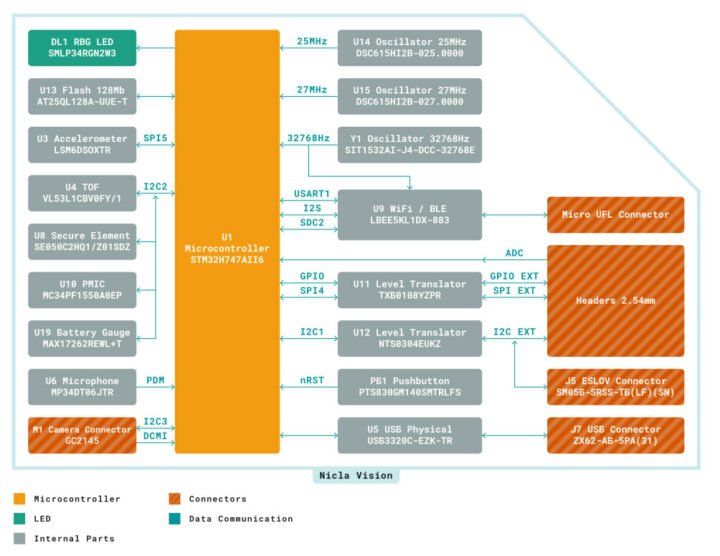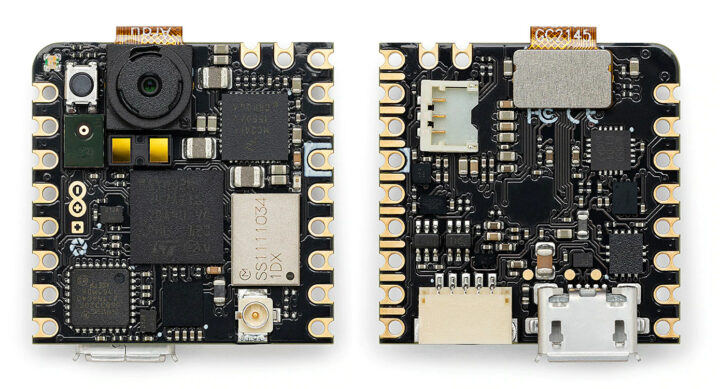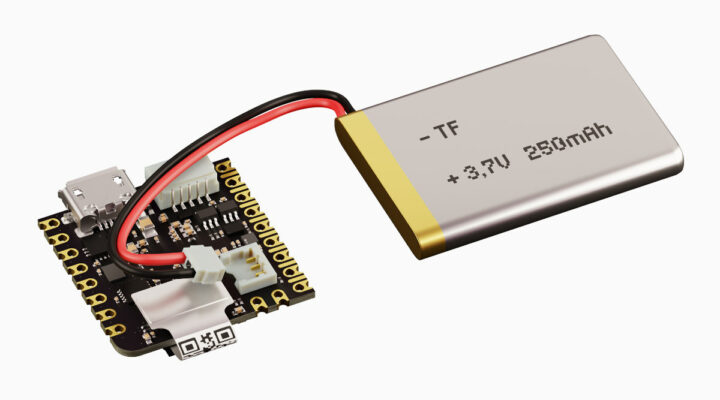Arduino Nicla Vision is an ultra-compact (~2.3×2.3 cm) board powered by an STMicro STM32H7 dual-core Cortex-M7/M4 microcontroller, and equipped with a 2MP camera, a WiFi & Bluetooth LE module, and a few sensors.
Those features make the board suitable for machine vision and edge computing applications such as asset tracking, image detection, object recognition, and predictive maintenance. For instance, image detection, facial recognition, automated optical inspection, vehicle plate reading, or gesture recognition can be added to projects, either using Nicla Vision as a standalone board or in combination with Portenta or MKR boards.
Arduino Nicla Vision specifications:
- Microcontrollers – STMicro STM32H757AII6 dual-core MCU with Arm Cortex M7 @ 480MHz, Cortex-M4 @ 240MHz, 2 MB flash, 1MB RAM
- Storage – 16MB QSPI flash
- Connectivity – 2.4GHz WiFi 802.11b/g/n up to 65 Mbps and Bluetooth 5.1 BR/EDR/LE via Murata 1DX module
- Camera – 2MP GC2145 color camera.
- USB – Micro USB port
- Sensors – 6-axis motion sensor, integrated microphone, and VL53L1 ToF distance sensor
- Expansion
- 10x digital I/O Pins of which 2 are shared with I2C and 4 are shared with SPI
- 2x analog input pins shared with PWM
- 12x PWM pins of which 2 are shared with analog, 2 are shared with I2C, and 4 are shared with SPI
- 12 external interrupts
- 1x UART, 1x I2C, 1x SPI
- DC Current per I/O pin – 4.7 mA
- HW security – NXP SE050C2 secure element
- Misc – 1x RGB LED
- Power
- Board Power Supply – 5V via USB/VIN
- MCU operating voltage – 1.8V translated to 3.3V on external pins
- 3-pin JST connector for 3.7V Li-ion/LiPo single-cell battery
- Dimensions – 22.86 x 22.86 mm
- Weight – 2 grams

The official website also lists a Nordic Semi nRF52832 Cortex-M4 MCU with 64kB SRAM, 512kB flash, but that must be a copy/paste mistake from the earlier Nicla Sense ME board that is indeed based on nRF52832.
The Nicla Vision board works with OpenMV, supports the Arduino IDE, Arduino Web, and MicroPython with connectivity to the Arduino Cloud or third-party vendor services, and it can be battery operated through a 3.7V LiPo or Li-Ion battery, but at the time of writing, Arduino did not provide any power consumption number with only “TBC” shown in the power consumption section of the datasheet. More details may be found on the documentation website.
Arduino Nicla Vision joins a fairly crowded market with low-power edge AI camera solutions with boards such as ESP32-CAM, Kendryte K210 based Maixduino, or even Wio Lite AI or OpenMV Cam H7 based on STM32H7 Cortex-M7 microcontrollers (but not Cortex-M4 core).
The Arduino board should perform much better than ESP32 and K210-based camera boards, and it comes in a more compact form factor and with more features than competing STM32H7 solutions. But all that goodness comes with a hefty price tag of 95 Euros or $115 US for the Nicla Vision board (codenamed ABX00051).

Jean-Luc started CNX Software in 2010 as a part-time endeavor, before quitting his job as a software engineering manager, and starting to write daily news, and reviews full time later in 2011.
Support CNX Software! Donate via cryptocurrencies, become a Patron on Patreon, or purchase goods on Amazon or Aliexpress. We also use affiliate links in articles to earn commissions if you make a purchase after clicking on those links.








I was seriously considering it until i hit the price tag $115. LOL, now that is a joke for sure.
Yup. Not use why you’d choose this over esp-cam.. performance, perhaps. For this price, I’d use an embedded Linux platform instead.. yes it’s small, but far too expensive
What’s the alternative? Can you please advice?
It sure is quite expensive, but depenending on its capabilities I think I could have bought it for the hexapod robot I was working on as a hobby. The problem is that I work on it only one week every few years and the first thing I do each time is to replace the control board with a way more powerful one, thus accumulating lots of almost unused but obsolete hardware 🙂
I just don’t understand the boards coming out of the Arduino company. They’re all over the place and there’s no seeming planning to them. They’re not even seeming competetors to existing boards (in the sense of being a viable product that approaches the feature set of an existing product from someone else).
What guides them? It just looks so random. (and horribly expensive)
Just to clarify this is an Industrial product built to industrial standards and temperatures. It’s designed to be used in industrial applications. Also the price is for quantity 1 , prices come down with quantity orders.
Not even, for me industrial temperature range means -40° C to +85° C, not -20° C to +70° C.
-50 to +95 would be even better /s
For this price and performance requirements I once again ask – why not use i.MX RT instead? Teensy 4.x (RT1064) has proven time and again that you can do so much more for less, surely industrial variant does not cost that much more than regular one?